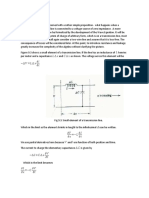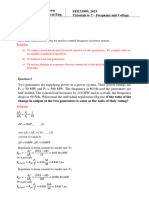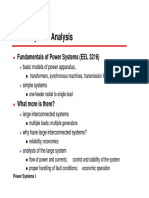0 ratings0% found this document useful (0 votes)
201 viewsZbus Building Algorithm
Uploaded by
Ishmum Monjur, 170021071Copyright
© © All Rights Reserved
Available Formats
Download as PDF or read online on Scribd
0 ratings0% found this document useful (0 votes)
201 viewsZbus Building Algorithm
Uploaded by
Ishmum Monjur, 170021071Copyright
© © All Rights Reserved
Available Formats
Download as PDF or read online on Scribd
You are on page 1/ 19
94, SYSTEMATICFAULT ANALYSIS USING BUS IMPEDANCE MATRIX. 363,
‘The prefault bus voltage is usually assumed to be 1.0 per unit, and we therefore
obtain from (9.6) the following approximate formula for the short-circuit caps
or the short-circuit MVA.
soc = 52 va On)
Xe
9.4 SYSTEMATIC FAULT ANALYSIS
USING BUS IMPEDANCE MATRIX
‘The network reduction used in the preceding example is not efficient and is not
applicable to large networks. In this section a more general fault circuit analysis
using nodal method is obtained. We see that by utilizing the elements of the bus
impedance matrix, the fault current as well as the bus voltages during fault are
readily and easily calculated.
Consider a typical bus of an n-bus power system network as shown in Fig-
ure 9.8. The system is assumed to be operating under balanced condition and a
per phase circuit model is used, Each machine is represented by a constant voltage
source behind proper reactances which may be X/, X4, or Xq. Transmission lines
are represented by their equivalent 1 model and all impedances are expressed in
per unit on a common MVA base. A balanced three-phase fault is to be applied at
bus k through a fault impedance Zy. The prefault bus voltages are obtained from
the power flow solution and are represented by the column vector
FIGURE 98.
Atypical bs of a power system,
364 9, BALANCED FAULT
v0)
Vius(0) = | Vi(0) 98)
Val)
As already mentioned, short circuit currents are so much larger than the steady.
state values that we may neglect the latter. However, a good approximation is to
represent the bus load by a constant impedance evaluated at the prefault bus volt
age,
4b = oe (9.9)
i
‘The changes in the network voltage caused by the fault with impedance Zy is
‘equivalent to those caused by the added voltage V4(0) with all other sources short-
circuited. Zeroing all voltage sources and representing all components and loads
by their appropriate impedances, we obtain the Thévenin’s circuit shown in Figure
9.9. The bus voltage changes caused by the fault in this circuit are represented by
the column vector
AY
AVins = | AV 9.10)
AVa
ft ay!
‘A typieal bus of a power system,
"pon
194, SYSTEMATIC FAULT ANALYSIS USING BUS IMPEDANCE MATRIX. 365
From Thévenin’s theorem bus voltages during the fault are obtained by superposi-
tion of the prefault bus voltages and the changes in the bus voltages given by
Vius(F) = Vius(0) + AVius (9.11)
In Section 6.2, we obtained the node-voltage equation for an n-bus network. The
injected bus currents are expressed in terms of the bus voltages (with bus 0 as
reference), ic.,
Tous = YourVivs @.12)
where Ipus is the bus current vector entering the bus and Y>,,, is the bus admittance
matrix. The diagonal element of each bus is the sum of admittances connected to
itie,
Dw j#i (9.13)
i
‘The off-diagonal element is equal to the negative of the admittance between the
buses, ie,
¥iy = Yin = vy (9.14)
where ys (lower case) is the actual admittance of the line i-j
refer to Section 6.2.
In the Thévenin’s circuit of Figure 9.9, current entering every bus is zero
except at the faulted bus. Since the current at faulted bus is leaving the bus, it is
taken as a negative current entering bus k. Thus the nodal equation applied to the
For more details
‘Thévenin’s circuit in Figure 9.9 becomes
0 va Vik 7 Min AY
—h(F) in ot Ua o> Yin | | AVE (9.15)
0 Yor + Yok 7 Yan | | AVa
or
Tous(F) = Yous Vous (9.16)
Solving for A Vous, we have
AVinus = ZousTous(F) 17)
366 9. BALANCED FAULT
where Zeus = Yay is known as the bus impedance matrix. Substituting (9.17) into
(9.11), the bus voltage vector during the fault becomes
Vins (0) + Ziuslius(F) 9.18)
Writing the above matrix equation i
WF)] [uO] fn
Vous (F)
terms of its elements, we have
Zn Zin 0
vetP) | = | va(0) | + | Zan o> Zee > Zin |] CF) | 2.19)
0
wtP)} Evin] [za
Since we have only one single nonzero element in the current vector, the kth equa-
tion in (9.19) becomes
Ve(P) = Vi(0) ~ Zeln(F) (9.20)
Also from the Thévenin’s circuit shown in Figure 9.9, we have
Vi(F) = Z/h(F) 21)
For bolted fault, Zy = 0 and Vi(F') = 0. Substituting for V,(F) from (9.21) into
(9.20) and solving for the fault current, we get
UP) = 7 (0.22)
‘Thus fora fault at bus k we need only the Zxx element of the bus impedance matrix.
This element is indeed the Thévenin’s impedance as viewed from the faulted bus.
Also, writing the ith equation in (9.19) in terms of its element, we have
VCP) = (0) — intel) 02)
‘Substituting for Jj,(F), bus voltage during the fault at bus i becomes
Zi
F) = ¥i(0) = 5 2 9.24
WA) = WO) — ZAR V0) 02H
With the knowledge of bus voltages during the fault, we can calculate the fault
current in all the lines. For the line connecting buses i and j with impedance 2,
the short circuit current in this line (defined positive in the direction i —» 5) is
Ty(e) = WB)
2
(9.25)
94, SYSTEMATICFAULT ANALYSIS USING BUS IMPEDANCE MATRIX. 367
‘We note that with the knowledge of the bus impedance matrix, the fault cur-
rent and bus voltages during the fault are readily obtained for any faulted bus in the
network. This method is very simple and practical. Thus, all fault calculations are
formulated in the bus frame of reference using bus impedance matrix Zyus
‘One way to find Zius is to formulate Ys, matrix for the system and then find
its inverse. The matrix inversion for a large power system with a large number of
buses is not feasible. A computationally attractive and efficient method for finding
Zs mattix is “building” or “assembling” the impedance matrix by adding one
network element at a time. In effect, this is an indirect matrix inversion of the
bus admittance matrix. The algorithm for building the bus impedance matrix is
described in the next section.
Example 9.2
A three-phase fault with a fault impedance Zy = 30.16 per unit occurs at bus 3 in
the network of Example 9.1. Using the bus impedance matrix method, compute the
fault current, the bus voltages, and the line currents during the fault,
In this example the bus impedance matrix is obtained by finding the inverse
of the bus admittance matrix. In the next section, we describe an efficient method
of finding the bus impedance matrix by the method of building algorithm.
To find the bus admittance matrix, the Thévenin’s circuit in Figure 9.2(b) is
redrawn with impedances converted to admittances as shown in Figure 9.10. The
ith diagonal element of the bus admittance matrix is the sum of all admittances
connected to bus i, and the ijth off-diagonal element is the negative of the admit-
tance between buses i and j. Referring to Figure 9.10, the bus admittance matrix
by inspection is
78.75 j125 725
Your =| 71.25 -§6.25 52.5
25 j25 — 75.0
Using MATLAB inverse function inv, the bus impedance matrix is obtained
40.16 50.08 70.12
Zine = | 50.08 70.24 70.16
50.12 50.16 50.34
From (9.22), for a fault at bus 3 with fault impedance Zp = 0.16 per unit, the
fault current is
Yl) _ 10__ 2.0 po
WP) = Zo 4Z, ~ j03i + 7016 ~
368 9, BALANCED FAULT
FIGURE 9.10
‘The admittance diagram for system of Figure 9.2 (b).
From (9.23), bus voltages during the fault are
Vi(F) = Vi(0) ~ Zisfs(F) = 1.0 ~ (70.12)(—72.0) = 0.76 pu
Va(F) = Va(0) ~ Zaals(F) 0 — (j0.16)(—J2.0) = 0.68 pu
Va(F) = Va(0) — Z3a13(F) = 1.0 — (j0.34)(—32.0) = 0.32 pu
From (9.25), the short circuit currents in the lines are.
Va(F) ~ Va(F)
228
The results are exactly the same as the values found in Example 9.1(a). ‘The reader
is encouraged to repeat the above calculations for fault at buses 2 and 1, and com-
Pare the results with those obtained from parts (b) and (c) in Example 9.1.
Note that the values of the diagonal elements in the bus impedance matrix
are the same as the Thévenin's impedances found in Example 9.1, thus eliminating
95. ALGORITHM FOR FORMATION OF THE BUS IMPEDANCE MATRIX. 369
the repeated need for network reduction for each fault location. Furthermore, the
off-diagonal elements are utilized in (9.24) to obtain bus voltages during the fault.
‘Therefore, the bus impedance matrix method is an indispensable tool for fault stud-
ies.
9.5 ALGORITHM FOR FORMATION
OF THE BUS IMPEDANCE MATRIX
Before we present the building algorithm for the bus impedance matrix, a few def-
initions from the discipline of the graph theory are introduced. The graph of a
network describes the geometrical structure of the network. The graph consists of
redrawing the network, with a line representing each element of the network. The
graph of the network for Figure 9.2(a) before the fault application is shown in Fig-
ture 9.11(a). The buses are represented by nodes ot vertices and impedances by
)
FIGURE 9.11
Graph, a selected tree, and a cotre for the network of Figure 9:20).
line segments called elements or edges. A tree of a connected graph is a connected
subgraph connecting all the nodes without forming a loop. The elements of a tree
are called branches. In general, a graph contains multiple trees. The number of
branches in any selected tree denoted by bis always one less than the nodes, ie.,
ben-1 (9.26)
where n is the number of nodes including the reference node 0. Once a tree for a
‘graph has been defined, the remaining elements are referred to as links. The cotlec-
tion of links is called a cotree. If e is the total number of elements in a graph, the
number of links in a cotree is
lse-b
an41 (9.27)
370 9. BALANCED FAULT
A loop that contains one link is called a basic Joop. The number of basic loops
is unique; it equals the number of links and is the number of independent loop
equations. A cut set is a minimal set of branches that, when cut, divides the graph
into two connected subgraphs. A fundamental cut set is a cut set that contains only
one branch, The number of fundamental cut sets is unique; it equals the number of
branches and is the number of independent node equations. Figure 9.11(b) shows
a tree of a graph with the tree branches highlighted by heavy lines and the cotree
links by dashed lines,
‘The bus impedance matrix can be built up starting with a single element and
the process is continued until all nodes and elements are included. Let us assume
that Zius matrix exists for a partial network having m buses and a reference bus 0
as shown in Figure 9.12,
Reference
FIGURE 9.12
Partial network
‘The corresponding network equation for this partial network is
Vous = Ziuslous 0:28)
For an n-bus system, m buses are included in the network and Zpus is of order
‘m x m, We shall add one element at a time from the remaining portion of the
network until all elements are included. The added element may be a branch or a
link described as follows.
ADDITION OF A BRANCH
‘When the added element is a branch, a new bus is added to the partial network
creating a new row and a column, and the new bus impedance matrix is of order
(m +1) x (m+ 1). Let us add a branch with impedance zpg from an existing bus
to anew bus q as shown in Figure 9.13(a). The network equation becomes
95. ALGORITHM FOR FORMATION OF THE BUS IMPEDANCE MATRIX. 371
1 1
2 12
Partial Pp q Partial TP
network -}—*————* network -—*
Fis | im Ts Lim
0 0 q
Reference Reference
@ )
FIGURE 913
[ado ofa branch pa
% Zn Ba Zap Zim Zag
vs Za ea oni
Vp |=] Zp. Zon oe Spy Zo Zon (929)
Vn | | Sm Zma - Zp + Bim Zing
Vel [Zn Zao Lap + Zam Zep
‘The addition of branch does not affect the original matrix, but requires the calcu-
lation of the elements in the q row and column, Since the elements of the power
system network are linear and bilateral, Zs = Zig, for g = 1,... 7.
First, let us compute the elements Z,: for i = 1,...,m and i # q (i.e
excluding diagonal element Zqq). To calculate these elements we will apply a cur-
rent source of 1 per unit at the ith bus, ic., J; = 1 pu, and keep remaining buses
open-circuited, ie., I {mand k # i. From (9.29), we get
(9.30)
From Figure 9.13(@)
Va = Vo tm 31)
372 9. BALANCED FAULT
Where tpy is the voltage across the added branch with impedance zg, and is given
by
pa = pai 0.32)
Since added element p-g is a branch, pg = 0, thus upg = 0 and (9.31) reduces to
Zu = 2p
To calculate the diagonal element Zyg, we will inject a current source of 1 per unit
at the qth bus, ic, fy = 1 pu, and keep other buses open-circuited, From (9.29),
we have
sm i¢g (9.33)
Vy= Zag (9.34)
Since at the qth bus, the injected current flows from the bus g towards the bus p,
‘pg = Iq = =1. Hence, (9.32) reduces to
pq = —Epq (935)
Subs
ting for vpg in (9.31), we got
Ve = Vp+ Zpq (936)
Now, since from (9.30) for i = q, Vy = Zqq and Vp = Zpq, (9.36) becomes
Zag = Lg + 29g 937)
Ifnode pis the reference node as shown in Figure 9.13(b), Vp = 0 and we obtain
Zui = yp =
sam ik (9.38)
From (9.37), the diagonal element becomes
2oa = 99 (9.39)
ADDITION OF A LINK
‘When the added element is a cotree link between the bus p and q, no new bus is
created. The dimension of the Zu, matrix remains the same bat all the elements
are required to be calculated. Let us add a link with impedance zpq between two
existing buses p and q as shown in Figure 9.14(a). If Zz is the current through the
‘added link in the direction shown in Figure 9.14(a), we have
Zpqle = Vp —Vq (9.40)
95, ALGORITHM FOR FORMATION OF THE BUS IMPEDANCE MATRIX. 373
1
cH
Partial | i
network |—4P
we LT,
jaa
|_§
Reference
@
FIGURE 9.14
‘Addition of a link pg.
or
network
es
Vy—Vo+2pale=0
aly
‘The added link modifies the old current Jp to (Jp — Je) and the old current I, to
(q+ Ie) as shown in Figure 9.14(a), and the network equation becomes
Vie Zuht
Zah+
Zah+ +
Van = Zrii
+Zip(Ip ~ Te) + ZaglIq + e+ +
+ tZpp(Ip ~ Ie) + ZpalIg + Le) +
+ ZaplIp ~ Te) + ZaglIq + Te) +
+2 mp(Ip — Te) + Za Iq + Te) -*
‘Substituting for Vp and V, from (9.42) into (9.41) results in
(Za — Zp ++
(Zam — Zpmn\len + (2pq + Zpp + Zaq ~ 2Zpq)le = 0
+Zimlm
+2 pmlm.
++ +Zomim
+Z mmm
+ (Zap — Zpp)p + +++ + (Zaa ~ Zpa)lq oo +
(9.42)
(9.43)
374 9, BALANCED FAULT
Equations in (9.42) plus (9.43) result in m +1 simultaneous equations, which is
written in matrix form as
v Zuo Zap Zig > Zim Ze] fh
Y Zp. > Bye Zpq ++ Lym Zoe | | Ip
Va f=] Za s+ Zap Zag ++ Zam Zqe || Iq | 9.44)
Vn 2mm Zrrm Ze | | Im
0 Za Zim Ze} | Te
where
(9.45)
and
Zee = 29q + Zpp + Zqq — 22 pq (9.46)
Now the link current I; can be eliminated. Equation (9.44) can be partitioned and
rewritten in compact form as
old
[Yer] =| Zo 32 | iw] 04
where
AZ=[ Ze + Zoe Zee 2me \" (9.48)
Expanding (9.47), we get
Vous = Zi Tous + AZIe (9.49)
and
O= AZT Iyus + Zeele (9.50)
or
Ie SE ne (9.51)
‘Substituting from (9.51) for Zz in (9.49), we have
Vine = [zeit - ABA? (9.52)
Zu
195, ALGORITHM FOR FORMATION OF THE BUS IMPEDANCE MATRIX. 375
ot
Vous = Zins Tous (9.53)
where
AZAZT
ew old
Bee = Big — (9.54)
Note that (9.54) reduces the matrix to its original size. The reason for this is that
wwe have not added a new node but only linked two existing nodes.
“The bus impedance matrix can be constructed with addition of branches and
links in any sequence. However, itis best to select a tree that contains the elements
connected to the reference node. If more than one element is connected between a
given node and the reference node, only one element can be selected as a branch
placing other elements in the cotree. The step-by-step procedure for building the
‘bus impedance matrix which takes us from a given bus impedance matrix Zits, to
anew Zpcis summarized below.
Rule
\ddition of a Tree Branch to the Reference
Start with the branches connected to the reference node. Addition of a branch zgo
between a new node q and the reference node 0 to the given Zit, matrix of order
(im x m), results in the ZY matrix of order (m+ 1) x (m+ 1). From the results
of (9.38) and (9.39), we have
Zy + Zim 0
gewn| i 0 0 9.55)
ms 0 Zane 0 _
0 0 20
‘This matrix is diagonal with the impedance values of the branches on the diagonal.
Rule 2: Addition of a Tree Branch from a New Bus to an Old Bus
Continue with the remaining branches of the tree connecting a new node to the
existing node. Addition of a branch zp between a new node q and the existing
node p to the given Z¢!d, matrix of order (m x m), results in the Ze” matrix of
order (m + 1) x (m+ 1). From the results of (9.33) and (9.37), we have
Zu Zip Zim Ap
a ee 056
Zang + Zum Zp
Up + Bam mv FF
376 9, BALANCED FAULT
Rule 3: Addition of a Cotree Link between two existing Buses,
When a link with impedance zy is added between two existing nodes p and q, we
augment the Zl4 matrix with a new row and a new column, and from (9.44) and
(9.45) we have
Ir Lap Bag Lam ag Zap
Zp Boe
Dias = Zp Zoq
Zima 2p 2g *
Za. Zp Zap—Zpp Zag Zon *
where
Zee = tq + Lop + Zqq — 22 pq 9.58)
‘The new row and column is eliminated using the relation in (9.54), which is re-
peated here
Azazt
Lys = Zig — (9.59)
a = is — (59)
and AZ is defined as
Zaq— Zip
=| 27 2p
az=| Poe (0.60)
Zina ~
‘When bus q is the reference bus, Z; = Zig
0
(for i = 1,m), and (9.57) reduces
Zp + Zim Zip
61)
Zana,
—an
‘95, ALGORITHM FOR FORMATION OF THE BUS IMPEDANCE MATRIX 377
where Zee = 299 + Zpp, and
(9.62)
The algorithm to construct the Zpus matrix by adding one element at a time
can be used to remove lines or generators from the network. The procedure is
identical to that of adding elements, except that the removed element is considered
‘as negative impedance, in order to cancel the effect of the element.
Based on the above algorithm, two functions named Zbus = zbuild(zdata)
and Zbus = zbuild(linedata, gendata, yload) are developed for the formation of
the bus impedance matrix. These functions are described in Section 9.6. Before
demonstrating this program, for the sake of better understanding the building algo-
rithm, we shall demonstrate the hand calculation procedure for the simple three-bus
network of Example 9.1.
Example 9.3
Construct the bus impedance matrix for the network in Example 9.1. The one-line
impedance diagram is shown in Figure 9.15(a).
FIGURE 9.15
Impedance diagram of Example 9.1 and a proper tee.
‘The elements connected to the reference node are included in the proper tree as
shown in Figure 9.15(b). We start with those branches of the tree connected to the
reference node. Add branch 1, 219 = 0.2 between node q = 1 and reference
3789, BALANCED FAULT
node 0. According to rule 1, we have
2) = Zy = a
Next, add branch 2, 299 = j0.4 between node q = 2 and reference node 0
2 -[% 0 ]_[ 902 0
mw 0 Ze Jl 0 joa
Note that the off-diagonal elements of the bus impedance matrix are zero. This is
because there is no connection between these buses other than to the reference. In
this example, there are no more branches from a new bus to the reference. We con-
tinue with the remaining branches of the tree. Add branch 3, z1 = 70.4 between
the new node q = 3 and the existing node p = 1. According to rule 2, we get
@ [2 42 Zn j02 0 502
2Q2.=| 21 22 Zr |=| 0 joa 0
By Zo Anta 502 0 506
All tree branches are in place. We now proceed with the links. Add link 4, 212 =
40.8 between node q = 2 and node p = 1. From (9.57), we have
Zu Zn fay Ean 2un
2) Zam Bay in — in
ca Zag Za 2,
2-2 taba Yay- Bra Zan
02 0 502 -702
0 04 0 504
50.2 0 706 —j0.2
50.2 50.4 -j0.2 Zyq
From (9.58)
Zsa = 21a Zur + Za — 22g = 50.8 + 50.2 + 0.4 — 250) = j1.4
and
AZAZT 1 [790.2
aq} i04 | [-s02 jo4 -jo2
Za ja we 402 PA —702]
~30.08714 50.1428 —j0,05714
0.02857 —30.05714 0.02857
70.02857 ~j0.05714 0.02857
95, ALGORITHM FOR FORMATION OF THE BUS IMPEDANCE MATRIX, 379)
From (9.59), the new bus impedance matrix is
j02 0 502 0.02857 —j0.05714 0.02857
z= | 0 jo4 0 |-| -j0.05714 70.11428 —j0.05714
702° 0 506 0.02857 —j0.05714 0.02857
0.17143 j0.08714 0.17143
= | 0.05714 5028571 70.05714
0.17143 j0.05714 50.57143
Finally, we add link 5, 223
(0.4 between node q = 3 and node p = 2. From
(0.57), we have
ay 22 43 Zis— Zia
7. | % %m =a tas In
us 2s 20, 23 xa Zan
21 ~ 2 232-2 Zsg— Fas Zan
0.17143 0.05714 0.17143 0.11429
_ | s005714 50.28571 j0.08714 ~30.22857
= | jo.17143 0.05714 5.57143 70.51429
50.1429 —70.22857 70.51429 Zu
From (9.58)
Zana 209+ Zant Zs — 222g = j0.4+§0.28571 + J0.57143 —2( 0.05714) = j1.14
and
T 0.11429
Bear. 1 | —jo2nse7 | [j0.11429 -jo22867 jo.s1420]
a d 50.51429
j0.01143 ~70.02286 0.05143
= | -y0.02286 0.04571 —70.10286
0.05143 —70.10286 70.23143
From (9.59), the new bus impedance matrix is
‘j0.17143 0.05714 j0.17143] f j0.01143 —70.02286 70.5143
Lous = [ms 15714 0.28571 50. wna] [= “70.0286 0.04571 pi
50.17143 30.05714 j0.57143] | 70.05143 —70.10286 0.23143
40.16 50.08 40.12
- [ae oat 21|
5012 70.16 70.34
This is the desired bus impedance matrix Zius, Which is the same as the one ob-
tained by inverting the Yius matrix in Example 9.2.
380 9, BALANCED FAULT
Example 9.4
‘The bus impedance matrix for the network shown in Figure 9.16 is found to be
FIGURE 9.16
Impedance diagram for Example 94,
0.183 0.078 70.141
Zeus = | 90.078 50.148 70.106
30.141 50.1068 50.267
The line between buses 1 and 3 with impedance Z3 = j0.56 is removed by the
simultaneous opening of breakers at both ends of the line. Determine the new bus
impedance matrix.
‘The removal of an element is equivalent to connecting a link having an impedance
equal to the negated value of the original impedance. Therefore, we add link 2;
—30.56 between node q = 3 and node p = 1. From (9.57), we have
Zn Za Za is Zn
lne=| 22 Zn Zn Zea Za
a Za 2a Ya Zan Zar
@- 2 Z2-2i2 ss - Lis 2
Thus, we get
40.183 0.078 0.141 ~j0.042
Zine =| 30:078 0148 70.106 70.028
ms | 50.141 70.106 70.267 50.126
30.042 50.028 0.126 Zag
96, ZBUILD ANDSYMFAULT PROGRAMS 381
From (9.58)
Zua= 213+ Zit 253-2213 = —J0.56 + j0.183 + j0.267—2(j0.141) =
and
o 30.042
ear = =pyq | 10.028 | [70.042 50.028 70.126 }
ad 70.302 | 0.196
“79.0030 —J0.0020 —70.0090
—j0.0045 50.0030 sn |
30.0135 30.0090 —0.0405
From (9.59), the new bus impedance matrix is
0.183 0.078 70.141 .0045 70.0030 0.0135
Zins [ 70.078 50.148, ‘uo | -| “40.0030 —70.0020 —. sc
50-141 30.106 70.267 30.0135 —30.0090 —30.0405
40.1875 0.0750 40.1275
= [® 0750 70.1500 za |
{70.1275 0.1150 70.3075
9.6 ZBUILD AND SYMFAULT PROGRAMS
‘Two functions are developed for the formation of the bus impedance matrix. One
function is named Zbus = zbuild(2data), where the argument zdata is an ¢ x 4
matrix containing the impedance data of an e-element network. Columns 1 and 2
are the element bus numbers and columns 3 and 4 contain the element resistance
‘and reactance, respectively, in per unit, Bus number 0 to generator buses contain
generator impedances. These may be the subtransient, transient, or synchronous re-
actances. Also, any other shunt impedances such as capacitors and load impedance
to ground (bus 0) may be included in this matrix.
‘The other function for the formation of the bus impedance matrix is zbus
= zbuildpi(linedata, gendata, yload), which is compatible with the power flow
programs. The first argument linedata is consistent with the data required for the
power flow solution. Columns 1 and 2 are the line bus numbers. Columns 3 through
5 contain line resistance, reactance, and one-half of the total line charging suscep-
tance in per unit on the specified MVA base. The last column is for the transformer
tap setting; for lines, 1 must be entered in this column. The lines may be entered in
any sequence or order. The generator reactances are not included in the linedata of
the power flow program and must be specified separately as required by the gen-
data in the second argument. gendata is an ng x 4 matrix, where each row contains
You might also like
- Three Phase Fault Analysis With Auto Reset Technology On Temporary Fault or Remain Tripped Otherwise50% (2)Three Phase Fault Analysis With Auto Reset Technology On Temporary Fault or Remain Tripped Otherwise4 pages
- Modelling of Load Flow Analysis in MatlabSimulink SoftwareNo ratings yetModelling of Load Flow Analysis in MatlabSimulink Software21 pages
- 2018 April Power Systems Analysis - EE306-A - Ktu QbankNo ratings yet2018 April Power Systems Analysis - EE306-A - Ktu Qbank3 pages
- Syllabus:: Electrical Dept. Electrical Power III Dr. Omar AlazzawiNo ratings yetSyllabus:: Electrical Dept. Electrical Power III Dr. Omar Alazzawi97 pages
- Experiment 2: Tripping Characteristics of Fuse & MCBNo ratings yetExperiment 2: Tripping Characteristics of Fuse & MCB17 pages
- LQR Tuning of Power System Stabilizer For Damping Oscillations100% (1)LQR Tuning of Power System Stabilizer For Damping Oscillations18 pages
- Rr410203-Computer Methods in Power Systems FinalNo ratings yetRr410203-Computer Methods in Power Systems Final8 pages
- EE4203 POWER SYSTEM 1 Lab Assignment 1 - Introduction To PowerWorld Per Unit Calculation 2023No ratings yetEE4203 POWER SYSTEM 1 Lab Assignment 1 - Introduction To PowerWorld Per Unit Calculation 202318 pages
- Transient Stability For IEEE 14 Bus Power System Using Power WorldNo ratings yetTransient Stability For IEEE 14 Bus Power System Using Power World8 pages
- ECE 476 Power System Analysis: Alejandro D. Dominguez-Garcia100% (1)ECE 476 Power System Analysis: Alejandro D. Dominguez-Garcia22 pages
- A Fast Instantaneous Method For Sequence Extraction: Rodrigo Cutri / Lourenço Matakas JuniorNo ratings yetA Fast Instantaneous Method For Sequence Extraction: Rodrigo Cutri / Lourenço Matakas Junior6 pages
- Power System Protection Lab: Department of Electrical EngineeringNo ratings yetPower System Protection Lab: Department of Electrical Engineering33 pages
- PSA - Lecture 6 - Symmetrical Fault Analysis (Part-1)No ratings yetPSA - Lecture 6 - Symmetrical Fault Analysis (Part-1)43 pages
- Extra High Voltage Ac Transmission Engineering by R D Begamudre PDF67% (3)Extra High Voltage Ac Transmission Engineering by R D Begamudre PDF2 pages
- Introduction To Graph Theory: March 2011No ratings yetIntroduction To Graph Theory: March 201111 pages
- Power Flow Analysis On Ieee 57 Bus System Using Matlab IJERTV3IS080738 PDFNo ratings yetPower Flow Analysis On Ieee 57 Bus System Using Matlab IJERTV3IS080738 PDF11 pages
- ECE 476 Power System Analysis: Lecture 11: Ybus, Power FlowNo ratings yetECE 476 Power System Analysis: Lecture 11: Ybus, Power Flow32 pages
- Transient Stability Improvement of An IEEE 9 BusNo ratings yetTransient Stability Improvement of An IEEE 9 Bus7 pages
- Power System Analysis: Fundamentals of Power Systems (EEL 3216)100% (1)Power System Analysis: Fundamentals of Power Systems (EEL 3216)29 pages
- Chapter Four Fault Analysis Using Z Bus Matrix (2)No ratings yetChapter Four Fault Analysis Using Z Bus Matrix (2)24 pages
- Extract CH 09 - Balanced Fault - Hadi Saadat - Power System Analysis-Pages-375-420No ratings yetExtract CH 09 - Balanced Fault - Hadi Saadat - Power System Analysis-Pages-375-42046 pages
- Chapter 9 Balanced Faults: Fault, and Double-Line-To-Ground Fault. All of These Are Unbalanced Faults. The BalancedNo ratings yetChapter 9 Balanced Faults: Fault, and Double-Line-To-Ground Fault. All of These Are Unbalanced Faults. The Balanced6 pages
- Three Phase Fault Analysis With Auto Reset Technology On Temporary Fault or Remain Tripped OtherwiseThree Phase Fault Analysis With Auto Reset Technology On Temporary Fault or Remain Tripped Otherwise
- Modelling of Load Flow Analysis in MatlabSimulink SoftwareModelling of Load Flow Analysis in MatlabSimulink Software
- 2018 April Power Systems Analysis - EE306-A - Ktu Qbank2018 April Power Systems Analysis - EE306-A - Ktu Qbank
- Syllabus:: Electrical Dept. Electrical Power III Dr. Omar AlazzawiSyllabus:: Electrical Dept. Electrical Power III Dr. Omar Alazzawi
- Experiment 2: Tripping Characteristics of Fuse & MCBExperiment 2: Tripping Characteristics of Fuse & MCB
- LQR Tuning of Power System Stabilizer For Damping OscillationsLQR Tuning of Power System Stabilizer For Damping Oscillations
- EE4203 POWER SYSTEM 1 Lab Assignment 1 - Introduction To PowerWorld Per Unit Calculation 2023EE4203 POWER SYSTEM 1 Lab Assignment 1 - Introduction To PowerWorld Per Unit Calculation 2023
- Transient Stability For IEEE 14 Bus Power System Using Power WorldTransient Stability For IEEE 14 Bus Power System Using Power World
- ECE 476 Power System Analysis: Alejandro D. Dominguez-GarciaECE 476 Power System Analysis: Alejandro D. Dominguez-Garcia
- A Fast Instantaneous Method For Sequence Extraction: Rodrigo Cutri / Lourenço Matakas JuniorA Fast Instantaneous Method For Sequence Extraction: Rodrigo Cutri / Lourenço Matakas Junior
- Power System Protection Lab: Department of Electrical EngineeringPower System Protection Lab: Department of Electrical Engineering
- PSA - Lecture 6 - Symmetrical Fault Analysis (Part-1)PSA - Lecture 6 - Symmetrical Fault Analysis (Part-1)
- Extra High Voltage Ac Transmission Engineering by R D Begamudre PDFExtra High Voltage Ac Transmission Engineering by R D Begamudre PDF
- Power Flow Analysis On Ieee 57 Bus System Using Matlab IJERTV3IS080738 PDFPower Flow Analysis On Ieee 57 Bus System Using Matlab IJERTV3IS080738 PDF
- ECE 476 Power System Analysis: Lecture 11: Ybus, Power FlowECE 476 Power System Analysis: Lecture 11: Ybus, Power Flow
- Power System Analysis: Fundamentals of Power Systems (EEL 3216)Power System Analysis: Fundamentals of Power Systems (EEL 3216)
- Chapter Four Fault Analysis Using Z Bus Matrix (2)Chapter Four Fault Analysis Using Z Bus Matrix (2)
- Extract CH 09 - Balanced Fault - Hadi Saadat - Power System Analysis-Pages-375-420Extract CH 09 - Balanced Fault - Hadi Saadat - Power System Analysis-Pages-375-420
- Chapter 9 Balanced Faults: Fault, and Double-Line-To-Ground Fault. All of These Are Unbalanced Faults. The BalancedChapter 9 Balanced Faults: Fault, and Double-Line-To-Ground Fault. All of These Are Unbalanced Faults. The Balanced


























































